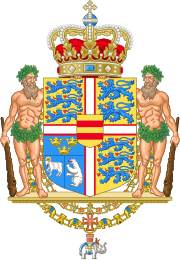
Back ملكية الدنمارك Arabic Monarchie v Dánsku Czech Dänische Monarchie German Monarquía de Dinamarca Spanish Monarchie danoise French המלוכה הדנית HE Monarki Denmark ID Danmarks monarki NB Monarquia da Dinamarca Portuguese Danska monarhija Serbo-Croatian
| King of Denmark | |
|---|---|
| Konge af Danmark | |
 | |
| Incumbent | |
 | |
| Frederik X since 14 January 2024 | |
| Details | |
| Style | His Majesty |
| Heir apparent | Christian, Crown Prince of Denmark |
| First monarch | Ongendus (first king known by name) |
| Formation | 710 |
| Residences | See list |
| Website | www |
 |
|---|
The monarchy of Denmark is a constitutional institution and a historic office of the Kingdom of Denmark. The Kingdom includes Denmark proper and the autonomous territories of the Faroe Islands and Greenland. The Kingdom of Denmark was already consolidated in the 8th century, whose rulers are consistently referred to in Frankish sources (and in some late Frisian sources) as "kings" (reges). Under the rule of King Gudfred in 804 the Kingdom may have included all the major provinces of medieval Denmark.[1]
The current unified Kingdom of Denmark was founded or re-united by the Viking kings Gorm the Old and Harald Bluetooth in the 10th century. Originally an elective monarchy, it became hereditary only in the 17th century during the reign of Frederick III. A decisive transition to a constitutional monarchy occurred in 1849 with the writing of the first democratic constitution, replacing the vast majority of the old absolutist constitution. The current Royal House is a branch of the ducal House of Glücksburg, originally from Schleswig-Holstein in modern-day Germany, the House of Glücksburg itself being a collateral branch of the House of Oldenburg. The House of Glücksburg also produced the monarchs of Norway, of the United Kingdom and the former monarch of Greece in the direct male line.
The Danish monarchy is constitutional and as such, the role of the monarch is defined and limited by the Constitution of Denmark. According to the constitution, the ultimate executive authority over the government of Denmark is still by and through the monarch's royal reserve powers; in practice these powers are only used according to laws enacted in Parliament or within the constraints of convention. The monarch is, in practice, limited to non-partisan functions such as bestowing honours and formally appointing the prime minister. The monarch and his or her immediate family undertake various official, ceremonial, diplomatic and representational duties.
King Frederik X ascended the throne following the abdication of his mother, Queen Margrethe II, on 14 January 2024. Danish regnal names have traditionally (since 1513) alternated between "Frederik" (previously anglicised to Frederick) and "Christian". Accordingly, Frederik's heir apparent is Crown Prince Christian.
- ^ Berend, Nora (22 November 2007). Christianization and the Rise of Christian Monarchy: Scandinavia, Central Europe and Rus' c.900–1200. Cambridge University Press. ISBN 9781139468367 – via Google Books.
© MMXXIII Rich X Search. We shall prevail. All rights reserved. Rich X Search